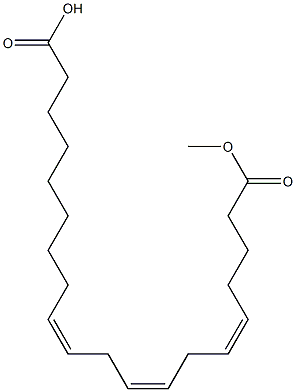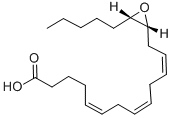Mead acid
- CAS NO.:20590-32-3
- Empirical Formula: C20H34O2
- Molecular Weight: 306.48
- MDL number: MFCD00065719
- EINECS: 200-578-6
- SAFETY DATA SHEET (SDS)
- Update Date: 2024-07-02 08:55:42

What is Mead acid?
Description
Mead acid is an omega-9 fatty acid, first characterized by James F. Mead. Like some other omega-9 polyunsaturated fatty acids animals can make Mead acid de novo. Its elevated presence in the blood is an indication of essential fatty acid deficiency . Mead acid is found in large quantities in cartilage.
Chemical properties
Mead acid, also referred to as eicosatrienoic acid, is chemically a carboxylic acid with a 20-carbon chain and three methyleneinterrupted cis double bonds. The first double bond is located at the ninth carbon from the omega end. In physiological literature, it is given the name 20:3(n-9) b. Mead acid can form various hydroxy (HETE) and hydoperoxy (HpETE) products .
The Uses of Mead acid
Mead Acid (20:3, n-9) is a precursor in biosynthesis of prostaglandins, thromboxanes and leukotrienes - anti-inflammatory.
What are the applications of Application
Mead Acid is an omega-9 fatty acid and anti-inflammatory precursor in the biosynthesis of prostaglandins, thromboxanes and leukotrienes.
Definition
ChEBI: An icosatrienoic acid with three cis-double bonds at positions 5, 8 and 11.
Properties of Mead acid
| Boiling point: | 440.0±24.0 °C(Predicted) |
| Density | 0.917±0.06 g/cm3(Predicted) |
| Flash point: | 14℃ |
| storage temp. | −20°C |
| solubility | 0.1 M Na2CO3: 1.7 mg/ml; DMF: 100 mg/ml; DMSO: 100 mg/ml; Ethanol: Miscible |
| form | Colorless oil. |
| pka | 4.75±0.10(Predicted) |
| color | Colorless to light yellow |
Safety information for Mead acid
| Signal word | Danger |
| Pictogram(s) |
 Flame Flammables GHS02  Exclamation Mark Irritant GHS07 |
| GHS Hazard Statements |
H225:Flammable liquids H319:Serious eye damage/eye irritation |
| Precautionary Statement Codes |
P210:Keep away from heat/sparks/open flames/hot surfaces. — No smoking. P280:Wear protective gloves/protective clothing/eye protection/face protection. P305+P351+P338:IF IN EYES: Rinse cautiously with water for several minutes. Remove contact lenses, if present and easy to do. Continuerinsing. P337+P313:IF eye irritation persists: Get medical advice/attention. P403+P235:Store in a well-ventilated place. Keep cool. |
Computed Descriptors for Mead acid
New Products
4-AMINO-TETRAHYDRO-PYRAN-4-CARBOXYLIC ACID HCL 4-(Dimethylamino)tetrahydro-2H-pyran-4-carbonitrile 4-Aminotetrahydropyran-4-carbonitrile Hydrochloride (R)-3-Aminobutanenitrile Hydrochloride 3-((Dimethylamino)methyl)-5-methylhexan-2-one oxalate 1,4-Dioxa-8-azaspiro[4.5]decane 5-Bromo-2-nitropyridine Nimesulide BP Aceclofenac IP/BP/EP Diclofenac Sodium IP/BP/EP/USP Mefenamic Acid IP/BP/EP/USP Ornidazole IP Diclofenac Potassium THOMAIND PAPER PH 2.0 TO 4.5 1 BOX BUFFER CAPSULE PH 9.2 - 10 CAP SODIUM CHLORIDE 0.1N CVS ALLOXAN MONOHYDRATE 98% PLATINUM 0.5% ON 3 MM ALUMINA PELLETS (TYPE 73) LITHIUM AAS SOLUTION 2-Bromo-1-(bromomethyl)-3-chloro-5-nitrobenzene 2-Bromo-3-nitroaniline N-(3-Hydroxypropyl)-N-methylacetamide 3-Bromo-6-chloropyridazine 4-ethyl-3-nitrobenzoic acidRelated products of tetrahydrofuran








You may like
-
 Mead acid CAS 20590-32-3View Details
Mead acid CAS 20590-32-3View Details
20590-32-3 -
 1-Methyl-6-oxo-1,6-dihydropyridazine-3-carbonitrile 98%View Details
1-Methyl-6-oxo-1,6-dihydropyridazine-3-carbonitrile 98%View Details
99903-60-3 -
 1823368-42-8 98%View Details
1823368-42-8 98%View Details
1823368-42-8 -
 2-(3-(tert-butyl)phenoxy)-2-methylpropanoic acid 1307449-08-6 98%View Details
2-(3-(tert-butyl)phenoxy)-2-methylpropanoic acid 1307449-08-6 98%View Details
1307449-08-6 -
 Ethyl 3-(furan-2-yl)-3-hydroxypropanoate 25408-95-1 98%View Details
Ethyl 3-(furan-2-yl)-3-hydroxypropanoate 25408-95-1 98%View Details
25408-95-1 -
 2-Chloro-5-fluoro-1-methoxy-3-methylbenzene 98%View Details
2-Chloro-5-fluoro-1-methoxy-3-methylbenzene 98%View Details
1805639-70-6 -
 1784294-80-9 98%View Details
1784294-80-9 98%View Details
1784294-80-9 -
 Lithium ClavulanateView Details
Lithium ClavulanateView Details
61177-44-4